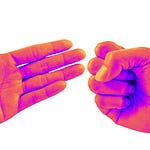Not everything that can be counted counts. Not everything that counts can be counted.
Attributed to Albert Einstein, but who knows?
How aware are you of your natural responses to threats?
A Tale of Fight-Flight-Freeze (I’ll Get to Fawn Later)
I had arrived that very day to my new home in rural Kentucky to start a job. My wife stayed in Iowa to pack, so my furniture was pretty sparse, just what I could fit into the Subaru: some camping chairs and a brand new air mattress — a good one, one of those double-thick ones. It would have to serve as my bed for a couple of months.
That first night, I slid onto my bed in the pitch dark and rested my iPhone on the corner of the mattress to charge. The house was large, very large, two stories with spacious rooms built into the side of a hill. As I settled in for the beginning of a long string of lonely nights, I thought how lucky we were to find this fantastic house to rent with its spectacular view of the Appalachian foothills and no neighbors in sight.
I nestled into my bed.
Whomp whomp!
What was that? It sounded like metal being bent or scraped in a large empty room. I was in a house full of large empty rooms! Where could it be coming from?
Whomp whomp!
I froze because that is what you do, right? You freeze and listen. It is like every nerve is ablaze. Your sense of hearing becomes so acute that you can almost detect dust settling around you. Your imagination runs wild trying to determine the source of the sound.
Nothing. Just the unfamiliar silence of my new house.
I waited and then started moving, just a little.
Whomp whomp!
Well, that confirmed it. I wasn’t dreaming. I was awake, wide awake this time, heart pounding and hyper-alert. That sound was real and it was loud. It didn’t sound like an animal, did it? Was someone trying to get in? It could be. I sat up wondering whether I was about to confront some intruder — man or beast. I readied myself to do battle. Where did I put that heavy flashlight? Or, wait! Maybe I could get out of there. How quickly could I get to my car? Where would I go?
Is there anything more instantly terrifying than a mysterious loud noise when you are half asleep and vulnerable in bed?
In just those few moments, I had already run through three of our natural threat reflexes, our ancient ancestors’ hardwired responses to danger. My mind and my body flooded with fear as my amygdala kicked in with with its familiar response: fight-flight-freeze.
The Fight-Flight-Freeze Response
In my line of work helping young bosses become great leaders, the fight-flight response often comes up. With so many stressors and threats in the daily workplace — be it malevolent bosses and colleagues, crises large and small, or just the dreaded deadline — fear and anxiety are ubiquitous. In the face of these threats, we often stand ready to do battle or run away.
More often, though, we just freeze. In the workplace for so many, maybe most, the freeze response is all-too familiar. Of course, freezing leaves you in a state of perpetual anxiety, but — unlike fight or flight — it has the benefit of preserving your job, at least for the time being. Fighting your boss is a bad idea, I can tell you from experience, and fleeing, while an effective solution, comes with its own challenges.
Freezing, though, can become habitual. Worse still, it can spread and merge with the organization’s culture. It can even infect an entire industry. Freezing can morph into the status quo.
The Freeze Response and the Status Quo
For years I have had this same dialogue with colleagues in and outside my workplaces.
You may have had similar conversations:
Colleague: We have been doing this thing for years, but we are not getting anywhere. Me: Then stop doing this thing. C: But we have to do it. M: No you don’t. When you have dug yourself into a deep hole, step one is stop digging. C: But if we don’t do this thing, what else can we do? M: I don’t know, but not that.
This is the freeze response institutionalized. Long ago, a system or procedure had been established to address a concern. Over time it became apparent that the system broke down, became irrelevant, or just never worked. Since there was no ready substitute, though, everyone kept operating as though they were doing something useful. To consider any alternative, to introduce any innovation, had itself become a threat and simply unthinkable.
The business just freezes collectively, locked in the death grip of the status quo. I have written about this institutionalized freeze state, which I call BCD or bureaucratic compulsive disorder, in a post with that same title.
That’s institutional freeze. Let me give you great example of industry-wide freeze from my experience in higher education: the infamous student evaluation of teaching or SET.
If you have gone to college in the past thirty years or so, you have almost certainly filled out these forms at the end of the semester. They have become so established that education professionals freeze at the threat of seeking alternatives.
The dirty open secret is that many studies have exposed the uselessness of SETs for years, but SETs are still the norm almost everywhere.
To be clear, I believe it is vital to capture student impressions of the quality of their instruction, but SETs fail at doing so with admirable consistency. All across higher ed, which habitually freezes in the face of change, these pointless evaluations prevail even as they damage reputations, protect bad teachers, and reward mediocrity.
And these are really smart people doing this. Sigh.
Their first step should be to stop doing the same stupid thing and expecting different results (a saying also dubiously attributed to Einstein). As is often the case, doing nothing would be as good as or even better than continuing on doing something misleading and even harmful.
Finally, Fawn
You may have noticed I left out the fawn of the fight-flight-freeze-fawn response to fear. I just learned of this one myself. To fawn in the face of a threat is when you try to appease the source of the threat. I guess for our ancient ancestors it would be like saying to an attacking bear, “nice, beary. Does beary want some berries.” The bribe might just work, right? In the workplace, if you just give into your nasty boss, capitulate to her ludicrous demands, stroke his gargantuan but somehow eggshell-like ego, you may just live to see another day.
Then again, no matter what, the bear has you cornered.
Fawning is the most insidious of these workplace threat responses because it directly empowers your toxic boss every time. Don’t they have enough power?
The Whomp Whomp
Oh, and that terrifying whomp whomp noise in the night? After I ran around the house searching for the source of the sound, I gave up and went back to bed still a bit freaked out.
Whomp whomp!
There it was again! I laid still awhile. Nothing. I then introduced some slight movement.
Whomp whomp!
Remember I said I put my phone on the air mattress? What I didn’t mention is that I don’t sleep with a pillow. (I know. I’m weird. Don’t judge me.) After some sleuthing I discovered the cord to my phone was bad. Consequently when I moved, the power would disconnect for a moment and then reconnect, causing the phone to buzz to let me know it was plugged in. Since both the phone and my head rested directly on the skin of the mattress, that small sound echoed through my queen-sized, double-thick, vinyl-covered air bubble and conducted itself right into my skull. The vibrations were amplified and diffuse, loud and seemingly coming from everywhere and nowhere.
Whomp whomp, indeed.
Mystery solved. I simply switched out the cord and slept like a baby, or maybe more like a young fawn.
I should have heeded the omen, though. Little did I know that my new boss was a bear.
Whomp whomp.
When you face anxiety or fear, how do you react? How can you regulate your fight-flight-freeze response? Should you ever fawn?
Self-awareness of your normal responses can generate healthier reactions, and I can help. Click below for your free consultation and gift.
Share your thoughts on this topic or participate in a discussion by leaving a comment below or by contacting me directly by email:
You’ll need to register with Substack to leave a comment, which is painless and free.
Please share this post on social media.
And don’t forget to SUBSCRIBE to have On Leading with Greatness sent weekly to your inbox. I look forward to hearing from you.
Intro and outro podcast theme music by LiteSaturation from Pixabay.
















Share this post